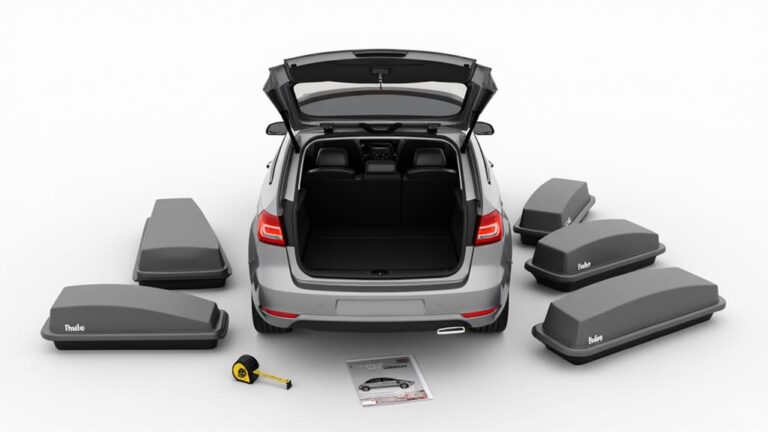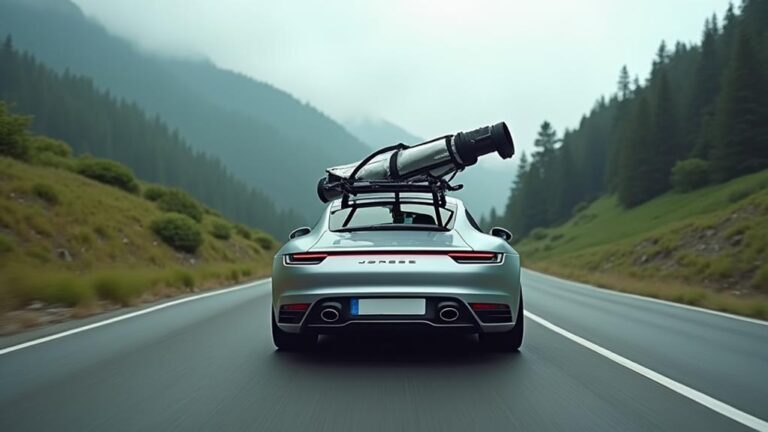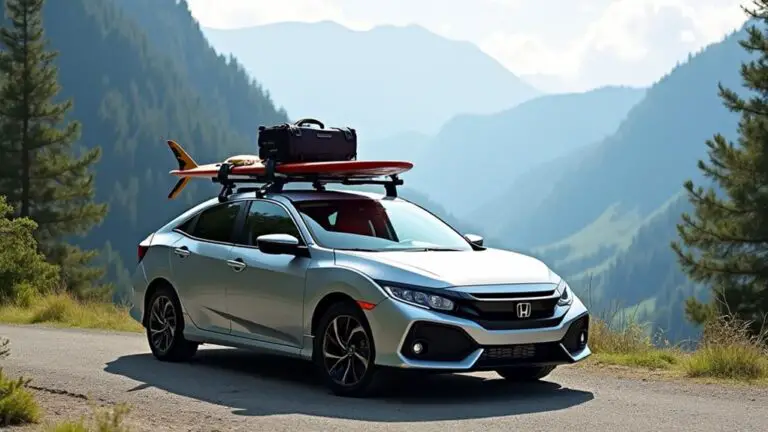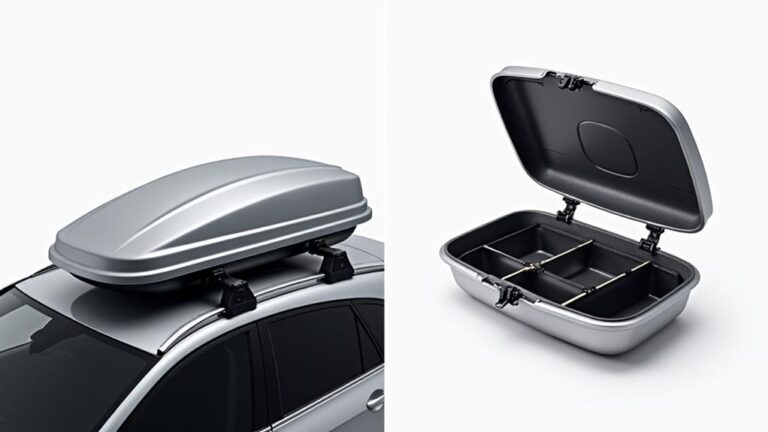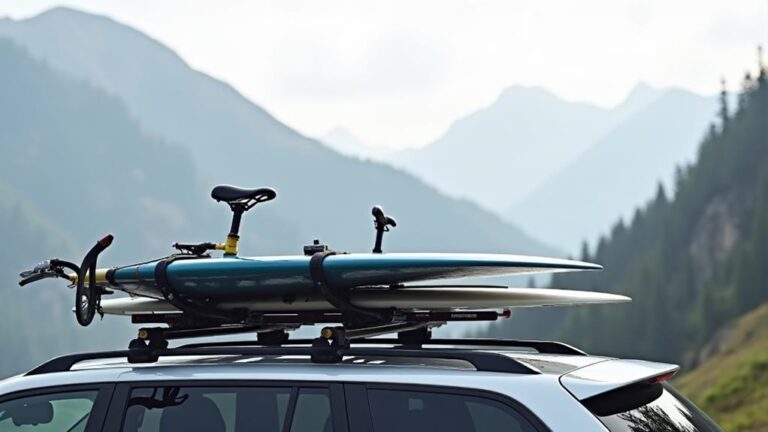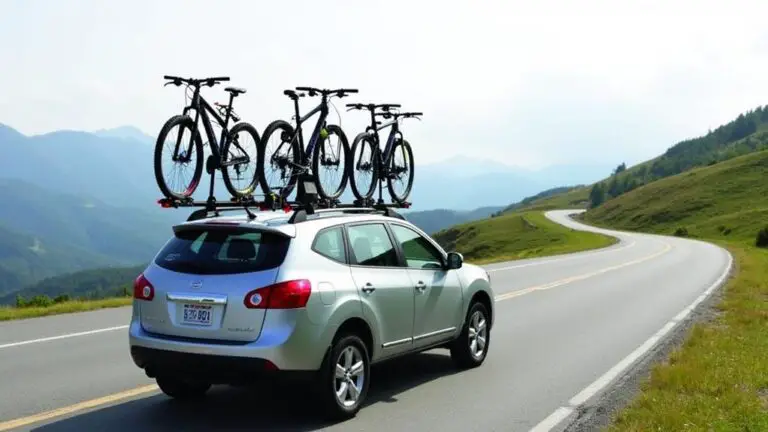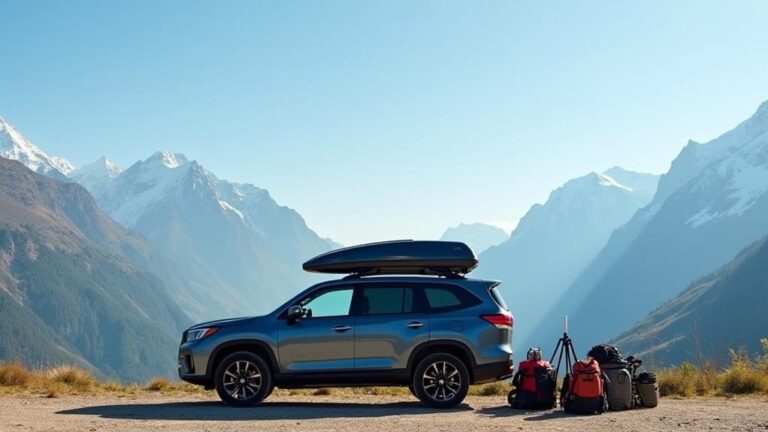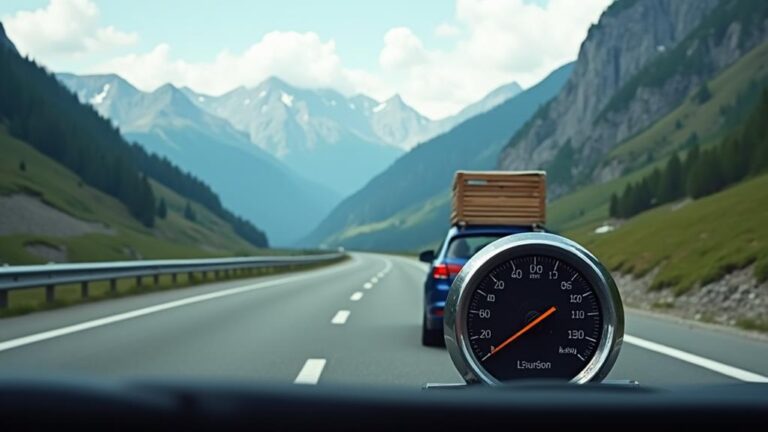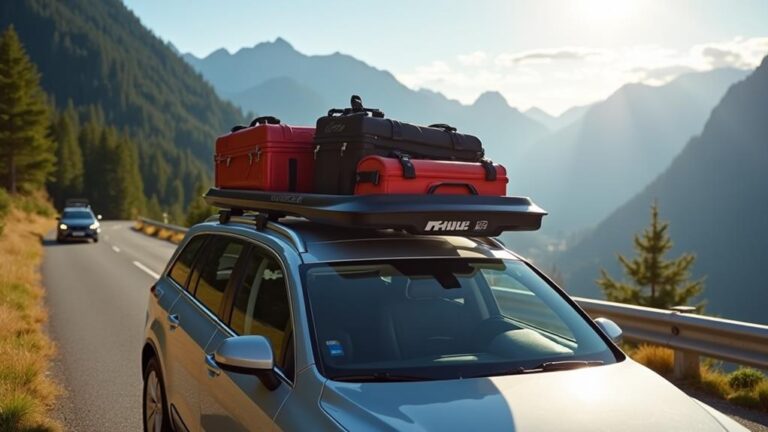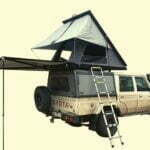Your car's roof is a blank canvas waiting for the perfect accessory, and a Thule roof box can be the ideal addition for your next adventure. However, with so many models and sizes available, finding the right one can be a daunting task. You've got to consider your vehicle's roof type, size, and load capacity to ensure a seamless fit. But where do you start? By understanding your car's unique characteristics, you'll be one step closer to finding the perfect Thule roof box. The question is, what are those key factors that will guide your decision?
Key Takeaways
- Determine your car's roof type: fixed points, raised rails, or flush rails to ensure Thule roof box compatibility.
- Measure your car's roof space and height profile to calculate available space for the roof box.
- Check your vehicle's gross vehicle weight rating (GVWR) to ensure the roof box weight capacity matches.
- Consider your gear-transporting needs and choose a Thule roof box style: Cargo Carrier, Vector, or Motion series.
- Verify the chosen Thule roof box model's compatibility with your vehicle's roof weight capacity and load restrictions.
Understanding Your Car's Roof Type
When shopping for a Thule roof box, understanding your car's roof type is crucial.
You'll need to determine your car's roof rail design, as it plays a significant role in choosing the right Thule roof box. There are several types of roof rail designs, including fixed points, raised rails, and flush rails.
Fixed points are small, raised brackets where the roof box attaches, while raised rails are elevated and run along the length of the roof.
Flush rails, on the other hand, are embedded in the roof and have a low profile.
In addition to the roof rail design, you'll also need to consider your car's top shape.
Is it curved, flat, or tapered? The shape of your car's roof will affect the type of Thule roof box you can use.
For example, a curved roof may require a roof box with a more flexible attachment system, while a flat roof can accommodate a wider range of roof boxes.
By understanding your car's roof type, you can narrow down your options and find the perfect Thule roof box for your vehicle.
This information will be essential in determining the best fit for your car.
Determining Your Car's Size Factors
To ensure a proper fit, you need to determine your car's size factors, which include its vehicle height profile, roof rack type, and car body length.
Measure your vehicle's height profile by noting the distance from the ground to the roof and any obstructions, such as roof rails or antennae.
You'll also need to identify your roof rack type, whether it's a fixed point, side rail, or gutter mount, and measure your car's body length to determine the maximum roof box length that will fit.
Vehicle Height Profile
You'll need to determine your car's overall height to ensure a secure and level installation of your Thule roof box.
Vehicle height is crucial in selecting the right roof box, as it affects the overall clearance of your car.
To determine your car's height, you'll need to consider the following factors:
- Unladen vehicle height: Measure the height of your car from the ground to the highest point of the roof.
- Roof antenna or fin height: If your car has a roof antenna or fin, add its height to the unladen vehicle height.
- Accessory height: Consider any existing roof accessories, such as roof rails or crossbars, and add their height to the total.
- Roof box height: Choose a roof box that fits within your car's height profile, leaving sufficient clearance for parking garages, drive-thrus, and other height-restricted areas.
When selecting a Thule roof box, ensure that it doesn't exceed your car's vehicle clearance, taking into account height restrictions and the added height of any existing roof accessories.
Roof Rack Type
Determining your car's roof rack type is crucial in selecting a compatible Thule roof box.
You'll need to identify the type of roof rack installed on your vehicle to ensure a secure and proper fit. Most roof racks are either fixed or removable, and they come in different rack material options, such as aluminum, steel, or fiberglass.
Each material has its own strengths and weaknesses, so it's essential to know what your rack is made of.
The installation methods used for your roof rack also play a significant role in selecting a compatible Thule roof box.
Some common installation methods include clamps, clips, or tracks. Clamps are usually used for fixed roof racks, while clips are often used for removable racks.
Tracks, on the other hand, provide a more permanent installation solution.
Knowing the installation method used for your roof rack will help you narrow down your options when choosing a Thule roof box.
Car Body Length
Most vehicles come in various body lengths, which significantly impact the size and type of Thule roof box that can be installed.
When determining your car's size factors, it's essential to consider its body length to ensure a proper fit.
Car body styles, such as sedans, hatchbacks, SUVs, and wagons, can have varying body lengths.
These lengths are usually categorized as compact, mid-size, full-size, or extended.
Your vehicle's dimensions will ultimately decide the maximum roof box size that can be accommodated.
To determine your car's body length, check the following:
- Manufacturer's specifications: Consult your car's owner's manual or the manufacturer's website for the official body length measurement.
- Vehicle dimensions label: Look for a label on the driver's side doorjamb or the fuel filler door, which usually provides the body length measurement.
- Online vehicle databases: Websites like Edmunds or Kelley Blue Book often provide vehicle dimensions, including body length.
- Physical measurement: Measure the body length yourself, from the front bumper to the rear bumper, to get an accurate reading.
Load Capacity and Weight Limits
When choosing a Thule roof box, its load capacity and weight limits are crucial factors to consider for safe and efficient transport of gear.
You need to ensure the roof box you select can handle the weight of the items you plan to transport. Weight restrictions vary across different Thule roof box models, so it's essential to check the specifications of the box you're interested in.
Thule roof boxes have weight limits that range from around 50 pounds to over 220 pounds, depending on the model and size.
You should also consider the weight distribution of the gear you plan to transport. Proper cargo optimization is key to safe transport. Make sure to distribute the weight evenly throughout the box to prevent any imbalance that could affect the stability of the vehicle while driving.
Additionally, you should also check the weight limit of your vehicle's roof to ensure it can handle the combined weight of the roof box and its contents.
Choosing the Right Roof Box Size
Choosing the Right Roof Box Size
How precisely do you need to size your Thule roof box to fit your gear? Roof box dimensions play a critical role in ensuring your gear fits comfortably and safely inside.
To choose the right size, consider the type of gear you need to transport, the roof space available on your vehicle, and the roof box's mounting system.
When selecting a Thule roof box, evaluate the box's interior space to ensure it can accommodate your gear.
Consider the following factors:
- Length: Measure your gear's length to ensure it fits within the box's interior space.
- Width: Calculate the width of your gear to guarantee it fits comfortably within the box's dimensions.
- Height: Determine the height of your gear to ensure it doesn't exceed the box's interior height.
- Volume: Calculate the volume of your gear to ensure the roof box's capacity can accommodate it.
Thule roof boxes come in various sizes, so it's essential to choose one that matches your gear's dimensions and your vehicle's roof space.
Thule Roof Box Style Options
Thule roof box style options offer a range of designs to complement your vehicle's aesthetic while also catering to your specific gear-transporting needs.
You'll find several styles to choose from, each with its unique characteristics and benefits.
Thule's Cargo Carrier series features a more rugged and angular design, making it ideal for those who prioritize durability and ease of loading.
If you're looking for a more streamlined appearance, consider Thule's Vector or Motion series.
These roof boxes boast sleek profiles and aerodynamic designs, reducing wind noise and drag while enhancing your vehicle's overall appearance.
The Vector series is notable for its premium, high-gloss finish, while the Motion series features a more minimalist approach with a textured, matte finish.
When selecting a Thule roof box style, consider your vehicle's roof type, as well as the gear you plan to transport.
Thule's various style options ensure you'll find a roof box that not only complements your vehicle but also meets your specific needs.
Key Features to Consider Now
You'll need to consider two crucial factors when selecting a Thule roof box: box size and vehicle compatibility.
Box size matters because it affects the overall fit and stability of the roof box on your vehicle, as well as the type and quantity of gear you can carry.
To ensure a proper fit, you'll also need to check your vehicle's compatibility with the Thule roof box you're interested in, taking into account factors like roof type, crossbar spacing, and load capacity.
Box Size Matters
When selecting a Thule roof box, size matters – it's crucial to consider the box's dimensions and features to ensure it fits your needs and vehicle.
To make an informed decision, you'll need to calculate your cargo needs and consider the box measurements.
1. Internal dimensions: Measure the internal length, width, and height of the roof box to ensure it can accommodate your gear.
2. External dimensions: Consider the external length, width, and height of the roof box, including any protrusions or overhangs, to ensure it fits on your vehicle's roof.
3. Cargo calculations: Calculate the volume of gear you plan to carry and match it to the roof box's capacity.
This will help prevent overloading and ensure safe transportation.
4. Hatch clearance: Consider the roof box's height and ensure it allows for sufficient hatch clearance when the rear door of your vehicle is open.
Vehicle Compatibility Check
Your vehicle's compatibility with a Thule roof box is crucial for safe and secure transportation. To ensure a proper fit, you'll need to research your vehicle's specs and compare them to the roof box's requirements.
Vehicle Compatibility Check
| Vehicle Specs | Thule Roof Box Requirements | Car Research Tips |
|---|---|---|
| Roof type (e.g., naked, flush, raised) | Roof box type (e.g., slide, lift) | Check your owner's manual or manufacturer's website |
| Roof length and width | Roof box length and width | Measure your roof's dimensions for accuracy |
| Crossbar type and spacing | Crossbar compatibility | Consult with a Thule dealer or customer support |
| Gross vehicle weight rating (GVWR) | Roof box weight capacity | Verify your vehicle's GVWR to ensure safe loading |
| Roof load capacity | Roof box weight and load capacity | Consult your owner's manual or manufacturer's website |
When researching your vehicle's specs, consider consulting your owner's manual, manufacturer's website, or contacting a Thule dealer. This information will help you determine the best Thule roof box for your vehicle, ensuring a safe and secure fit.
Measuring Your Car's Roof Space
Measuring your car's roof space accurately is crucial for selecting the right Thule roof box.
To ensure a proper fit, you'll need to calculate the available space and consider various factors that affect the roof box's position.
When taking measurements, consider the following key aspects of your car's roof space:
- Length: Measure the distance between the front and rear crossbars to determine the maximum length of the roof box that can fit.
- Width: Measure the distance between the side rails or the roof's edge to determine the maximum width of the roof box that can fit.
- Height: Measure the distance from the roof's surface to the lowest point of the overhead obstruction (e.g., the sunroof or car antenna) to determine the maximum height of the roof box that can fit.
- Obstructions: Check for any obstructions, such as roof vents or luggage carriers, that may affect the roof box's position or installation.
Using these measurement techniques, you can accurately calculate your car's roof space and ensure a proper fit for your Thule roof box.
Selecting the Perfect Thule Model
You've now measured your car's roof space and have a clear understanding of the available dimensions.
It's time to select the perfect Thule roof box model that suits your needs. The Thule brand offers a wide range of roof boxes in various styles, sizes, and capacities.
When choosing a Thule model, consider the roof style of your car. If you have a naked roof, a Thule roof box with a low-profile design would be suitable.
For cars with raised side rails, a Thule model with a click-and-go system would be ideal. If your car has flush side rails or a fixed point system, a Thule model with a slide-and-lock system would be the best fit.
Next, think about your luggage capacity needs.
Thule roof boxes come in various sizes, ranging from 320 to 610 liters. Consider the type of gear you plan to carry and the number of passengers in your vehicle.
Also, ensure the roof box is compatible with your car's roof weight capacity.
Frequently Asked Questions
Are Thule Roof Boxes Compatible With Sunroof Openings?
You'll need to check sunroof clearance and ensure the Thule roof box doesn't obstruct it. Measure your sunroof's width and height to determine compatibility, also considering any roof obstructions, such as antenna or rails.
Can I Install Thule Roof Boxes on a Leased Vehicle?
Think twice before altering your leased vehicle – can you really afford the potential fallout? You'll need to review your lease agreement for any restrictions on vehicle modifications before installing a Thule roof box.
How Often Should I Inspect My Thule Roof Box?
You should inspect your Thule roof box regularly, ideally every 3-6 months, to ensure proper roof box maintenance. Focus on Regular cleaning of the box's exterior, seals, and locking mechanism to prevent damage.
Can Thule Roof Boxes Be Used on Camper Vans?
You'll find that 75% of camper van owners use roof storage. When it comes to camper van conversions, Thule roof boxes can be used, but you'll need to consider Van roof racks specifically designed for your vehicle's weight capacity.
Are Thule Roof Boxes Covered by Warranty?
You'll be covered with Thule's warranty, which typically lasts 2-5 years depending on the product. When filing Thule warranty claims, gather proof of purchase and documentation to ensure a smooth process within the warranty duration.
Conclusion
You've spent hours researching and measuring, and now it's ironic that choosing the right Thule roof box is actually the easiest part. With a clear understanding of your car's roof type, size, and load capacity, selecting the perfect model is a breeze. Consider your gear's dimensions and ensure the roof box fits, providing adequate hatch clearance. Don't forget to check Thule's style options and key features. Now, find the perfect match and hit the road with confidence.
